Ted Bundy. Jeffrey Dahmer. Richard Ramirez. All serial killers identified and captured by authorities after local and nationwide manhunts. But the Zodiac killer, one of the most famous serial killers of all time, remains unnamed nearly 55 years after his first confirmed kills.
On December 20, 1968, high school students Betty Lou Jensen and David Arthur Faraday were on their first date. Around 10:15 p.m., they pulled over to a lovers’ lane within the city limits of Benicia, California, to be alone. Investigators believe that just before 11 p.m., another car parked beside the couple and a man stepped out, possibly ordering the couple out of their own vehicle. It is suspected that Faraday exited the vehicle first and was shot in the head when he was halfway out. Jensen took off running, and the killer shot her five times in the back. Her body was found 28 feet from the car. Their deaths became known as the Lake Herman Road murders.
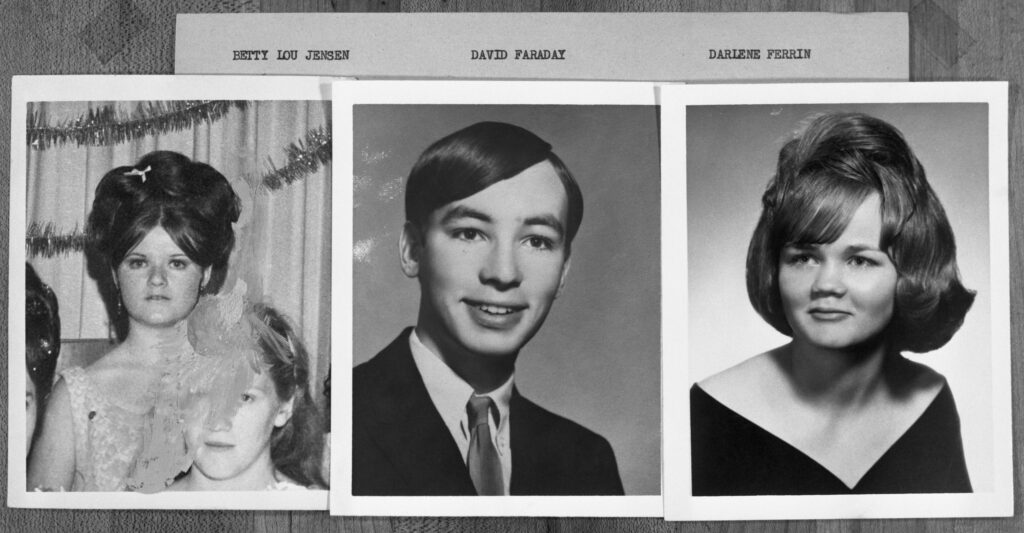
Bettmann / Contributor. Getty Images. San Francisco murder victims; Betty Lou Jensen, David Faraday, and Darlene Ferrin, alleged to be victims of the Zodiac Killer.
The next murder attributed to the Zodiac came on July 4, 1969, at Blue Springs Park in Vallejo. Just before midnight, Darlene Ferrin and Michael Mageau parked and sat in the car until a second car parked next to them. The second car almost immediately pulled away, but about 10 minutes later, it returned and parked behind them. The driver got out with a flashlight and a handgun, shined the flashlight in the couple’s eyes and then shot at them five times. Ferrin and Mageau were both hit, and several bullets went through Mageau into Ferrin. The killer then walked away from the couple but returned to shoot each victim twice more before leaving.
Ferrin was pronounced dead following the incident, but Mageau survived and told police his attacker was a 26-to-30-year-old white male, about 5 feet 8 inches tall, around 195 to 200 pounds, which short, curly light brown hair.
Around 12:40 a.m. on July 5, a man called the Vallejo Police Department from a phone booth at a gas station three miles away to report the murders and take credit for them. He also claimed to have killed Faraday and Jensen the previous year.
About a month after the attack, someone claiming to be the killer sent letters to the San Francisco Chronicle, The San Francisco Examiner, and the Vallejo Times Herald. The letters were nearly identical, except each one contained one third of a cryptogram the author said contained his identity. In the letters, he also claimed credit for the Lake Herman and Blue Rock killings while demanding they be printed on the paper’s front page. If they weren’t, the author threatened to drive around on the weekend and kill “a dozen people.”
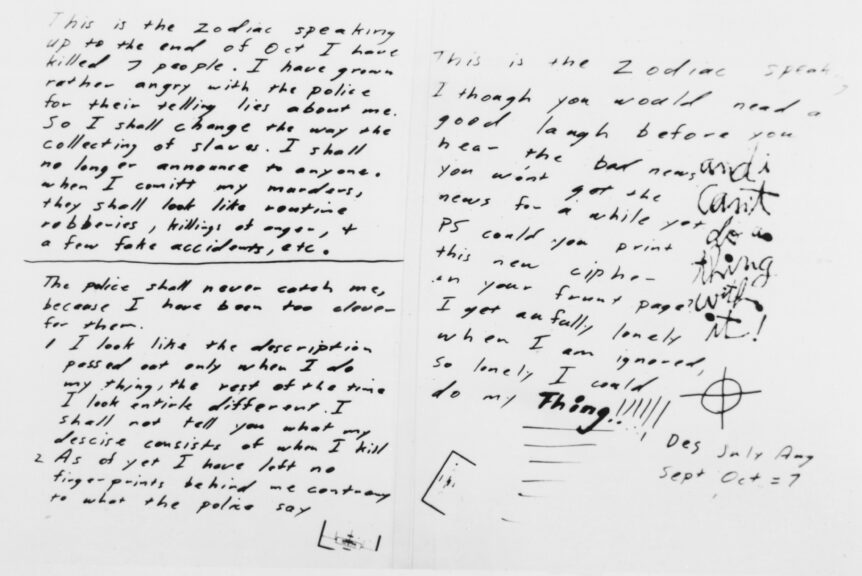
Bettmann / Contributor. (Original Caption) San Francisco, California: The “Zodiac” killer broke his silence to boast in letters and cryptograms that he has now murdered seven persons.
The Chronicle published its portion of the cryptogram on page four alone with a quote from the Vallejo Police Chief saying he didn’t think the letter was written by the actual killer and asked the writer to send in more facts to prove who he was.
Twelve people did not die over the weekend as threatened, and all three portions of the cryptogram were eventually published.
About a week after the first letters were sent, the Examiner received a second letter where the author identified himself as “the Zodiac.” This letter provided details of the killings that hadn’t been released yet to the public, and the author again said that if they solved the cryptogram they would have their murderer.
The day after the second letter was sent, Donald and Bettye Harden of California seemingly solved the cryptogram. It contained numerous spelling errors and referenced the fictional story “The Most Dangerous Game,” but did not name the killer.
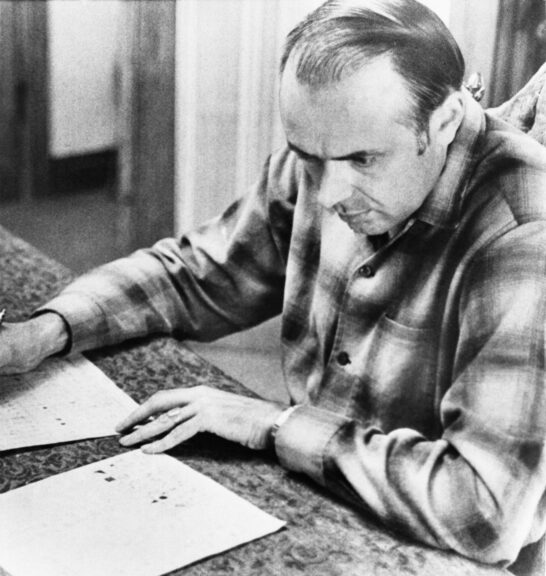
Bettmann / Contributor. Donald G. Harden, school teacher at Alisal High in Salinas, is the man who broke the code of the psychotic killer who calls himself “Zodiac.”
The cryptogram, according to the Hardens, contained the following message (all typos original):
I like killing people because it is so much fun it is more fun than killing wild game in the forrest because man is the most dangeroue anamal of all to kill something gives me the most thrilling experence it is even better than getting your rocks off with a girl the best part of it is thae when I die I will be reborn in paradice and all the I have killed will become my slaves I will not give you my name because you will try to sloi down or atop my collectiog of slaves for my afterlife ebeorietemethhpiti.
On September 27, 1969, Pacific Union College students Bryan Hartnell and Cecelia Shepard decided to have a picnic on a small island on Lake Berryessa. At some point, a white man about 5 feet 11 inches tall and weighing more than 170 pounds approached the couple wearing a black hood with sunglasses and a symbol on his chest of a circle with a cross through it. The man raised a gun at the couple and told them he was an escaped convict from another state and had already killed a guard and stolen a car. He demanded the couple give him their car so he could flee to Mexico.
The man then gave Shepard precut lengths of clothesline and told her to tie up Hartnell. The man then tied up Shepard and checked her work, tightening the line around Hartnell’s hands. Instead of simply stealing the car and leaving, the man then stabbed Hartnell and Shepard repeatedly, killing Shepard and severely wounding Hartnell.
The killer then drew the circle with a cross symbol on the car door along with other notes:
Vallejo
12-20-68
7-4-69
Sept 27–69–6:30
by knife
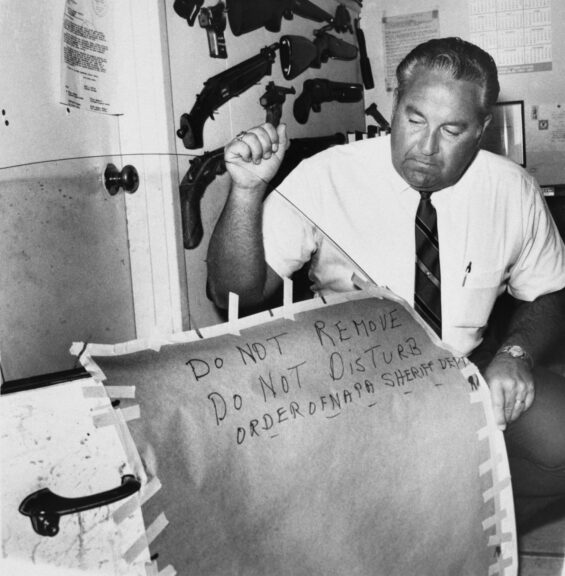
Bettmann / Contributor. Getty Images. Captain Don Townsend displays door of auto belonging to stabbing victim Bryan Hartnell, 20, of Troutdale, Oregon.
The killer allegedly called the Napa County Sheriff’s office from a payphone to take credit for the killings, say he wanted to “report a murder – no, a double murder,” before saying he was the killer. Police were able to get to the payphone, which was near the sheriff’s office, and lift a palm print, but have never been able to match it to anyone.
A man and his son who were fishing near Hartnell and Shepard heard their screams and called park rangers. Sheriff’s deputies arrived to help the couple. Shepard was conscious and provided a detailed description of her attacker, but went into a coma while being taken to the hospital and never woke up, dying two days later. Hartnell survived the attack and told the media what had happened to him.
Two weeks after the attack at Lake Berryessa, Paul Stine was driving his cab in San Francisco when a white man entered and told him to drive to Presidio Heights. Stine, for some reason, drove a block past where the man asked to be dropped off, and the passenger shot him in the head with a handgun, took his wallet and keys, and ripped off a section of his bloodied shirt. Three teenagers saw what happened and reported it to police.
Initially, police believed the murder to be a robbery gone wrong, but on October 13, the Zodiac sent a letter to the Chronicle taking credit for the crime. He included the torn piece of shirt as proof he had committed the crime. He also in this letter threatened to kill children riding a school bus.
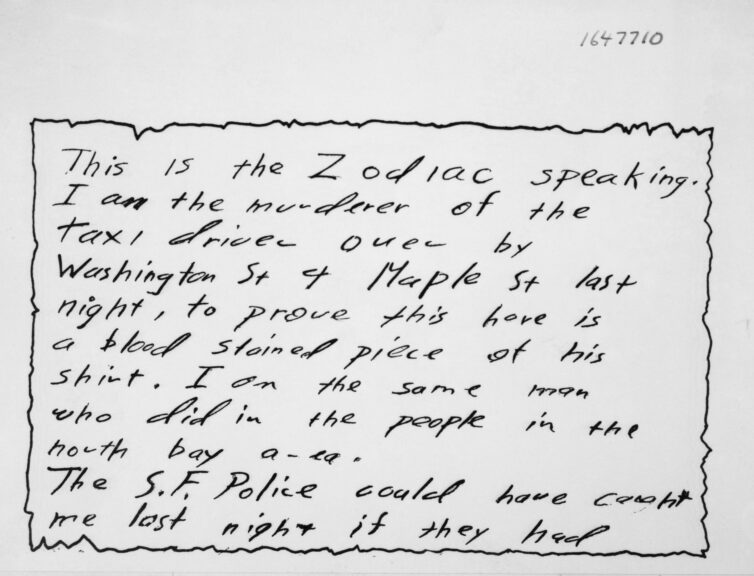
Bettmann / Contributor. A letter and a blood-soaked piece of shirt have alerted San Francisco police to the possibility that the slayer of cab driver Paul Stine.
On November 8, 1969, a person believed to be the Zodiac sent another cryptogram, known as the “340 cipher” because of the number of characters included, which remained unsolved for 51 years. In December 2020, however, three amateur code breakers believed they cracked the cipher. The code was allegedly solved by Virginia software developer David Oranchak, Belgian computer programmer Jarl Van Eycke, and Australian mathematician Sam Blake. They believe the message contains a misspelling of the word “paradise,” but says:
I hope you are having lots of fun in trying to catch me
That wasn’t me on the TV show which brings up a point about me
I am not afraid of the gas chamber because it will send me to paradice all the sooner
Because I now have enough slaves to work for me where everyone else has nothing when they reach paradice so they are afraid of death
I am not afraid because I know that my new life will be an easy one in paradice death.
The TV show reference is to “The Jim Dunbar Show,” a television talk show that aired in the San Francisco area. In 1969, a man claiming to be the Zodiac killer called into Dunbar’s show repeatedly, saying a few words before hanging up each time. The cipher that has been decoded was sent to the Chronicle two weeks after the show aired. The man who called in was found to be a mental patient with no connection to the Zodiac.
In addition to the above confirmed victims, there are 13 additional victims speculated to have been killed by the Zodiac. Raymond Davis, Robert Domingos and his fiancée Linda Edwards, newlyweds Johnny and Joyce Swindle, Cheri Jo Bates, couple Enedine Martinez and Fermin Rodriquez, John Hood and his fiancée Sandra Garcia, Kathleen Johns, Richard Radetich, and Donna Lass are all speculated as Zodiac victims.
The most well known of these alleged victims is Cheri Jo Bates, who was murdered on October 30, 1966, after studying at the Riverside City College library annex. She left the annex when it closed at 9 p.m., and neighbors reported hearing a scream an hour and a half later. Bates’ body was found the following morning between two abandoned houses on campus.
A month after her murder, two nearly identical letters were sent to the Riverside police and the Riverside Press-Enterprise, in which the author claimed credit for Bates’ murder and said she was neither the first nor the last victim. The letter contained details about Bates’ murder that hadn’t been released to the public, and the handwriting was similar to that of the Zodiac letters.
Six months after Bates’ murder, her father, the police, and the Press-Enterprise all received nearly identical letters.
In 2016, the author of the letters was identified through DNA analysis. He apologized and admitted to committing a hoax by writing the letters and that he had been a troubled teenager seeking attention. He was determined not to be the Zodiac.
Another letter was sent to the Los Angeles Times five months after Bates’ murder, believed to have been sent from the actual Zodiac. He claimed credit for the murder, and said there were more bodies in Riverside, California. It is still unclear whether the Zodiac is actually connected to Bates’ murder. The Riverside Police Department has said the Zodiac was not responsible, but acknowledged that the Zodiac may have sent letters to falsely claim credit.
Many men have been accused of being the Zodiac killer, but two have been the most notorious. Arthur Leigh Allen has been accused of the killing, with some limited circumstantial evidence (he owned the same typewriter as was used to type the Zodiac’s letters, he wore a Zodiac wristwatch, and lived near one of the victims), but no solid evidence ever pointed to his involvement. In fact, the San Francisco Police Department in 2002 compared partial DNA found on the stamps used on Zodiac’s letters to Allen, but there was no match. Further, a retired police handwriting expert said Allen’s writing didn’t even come close to resembling the Zodiac’s.
In October 2021, Case Breakers, a volunteer group of investigators led by investigative journalist Thomas Colbert, claimed to have identified Air Force veteran Gary Francis Poste as the Zodiac. Poste died in 2018. The identification has been questioned by police and Zodiac experts, who say the Case Breakers’ identification relies on circumstantial evidence and claims that weren’t made by witnesses. For example, the Case Breakers said Poste had scars on his forehead similar ones on the killer’s head, but author Tom Voigt, who has investigated the killer, said that no witnesses claimed the killer had scars on his forehead.
In May 2023, Case Breakers again professed that Poste was the Zodiac, saying that he had been listed as a “suspect” at FBI headquarters in Quantico, Virginia. They attributed the claim to “a senior FBI agent.”
“The felon has been secretly listed as the Zodiac ‘suspect’ in Headquarters’ computers since 2016 – with his ‘partial DNA’ safely secured at the feds’ Quantico, Virginia lab,” Case Breakers claimed.
The FBI maintains that the case is still unsolved and remains open and active.
In a press release, Case Breakers claimed it had found DNA on a hiking mat Poste owned and confirmed the DNA using a living relative. The group has asked the FBI to compare that DNA to hairs found on Cheri Jo Bates, believed by the group to be one of the Zodiac’s victims.
Numerous people have claimed to be relatives of someone they believe to have been the killer.
Other serial killers have been cleared as suspects in the Zodiac killings. Ted Bundy, Edward Edwards, Ted Kaczynski, and the Manson family were all posited as the killers but eliminated as suspects for various reasons.
There have also been several Zodiac copycat killers, such as Heriberto Seda in New York City and a 14-year-old boy in Japan, who used the alias Seito Sakakibara but has been identified in various outlets as Shinichiro Azuma.
The real Zodiac continued to write letters to law enforcement and news outlets until his final confirmed letter, postmarked January 29, 1974. In his final letter, he claimed to have killed 37 people. Additional letters, suspected of being hoaxes made to look like the Zodiac, were also sent to news outlets for decades after the killings.
With everything known about the Zodiac and with so many serial killers caught and identified, it seems inconceivable that we still don’t know who committed these killings, or whether the Zodiac was telling the truth about killing 37 people. Maybe advances in forensic technology will be able to identify the killer and finally close this decades-long trail of death.

Continue reading this exclusive article and join the conversation, plus watch free videos on DW+
Already a member?

.png)
.png)

